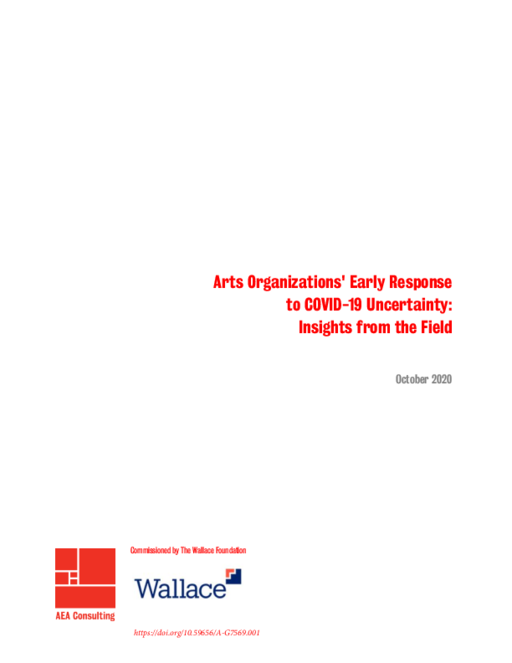Breadcrumb
- Wallace
- Reports
- Arts Organizations’ Early Respon...
Arts Organizations’ Early Response to COVID-19 Uncertainty
Insights from the Field

Overview
More
Less
Summary
Between mid-March and June 2020, the authors of this report interviewed or surveyed more than 160 arts leaders and field experts on the implications for the arts of COVID-19 and developments including the then-emerging racial justice movement. The arts leaders also were asked about their strategies and priorities for responding to the uncertainties of the moment.
The findings in the report, by AEA Consulting, underscore the view that the pandemic and other developments have heightened trends already under way, including the fragile and unsustainable nature of the business models in the arts; the need for greater understanding of audience behaviors and preferences; the imperative to develop a compelling online presence; and the need to revisit the strategic alignment between organizations’ programs and missions.
Although responses from the leaders varied, they had several commonalities, the report finds. Among them:
- A sense that however the U.S. emerges from the immediate crisis of COVID-19, arts organizations will find themselves in a less predictable and more turbulent environment, where adaptability and resilience will be high on any institutional agenda;
- A need to produce virtual content in a systematic and strategic way as a permanent part of artistic creation and distribution;
- A greater openness to experimentation and innovation—and, with that, to risk and the possibility of failure; and
- A realization that during a recession, donors may give greater weight to the “relevance” or perceived social impact of art institutions when they consider their giving.
Among highlights from the survey:
- Audience behavior: 73 percent of respondents agree that the socioeconomic divide may widen between those who participate in the arts in person and those who do not.
- Income sources five years from now: 54 percent expect a decrease in ticket sales; 35 percent expect an increase in profits from online sales.
- Future operations (two to five years from now): 79 percent expect a change in the diversity and quality of digital programming; 59 percent expect introduction of new income streams.
- Dealing with impact of the COVID-19 pandemic: Access to reliable audience data and projections; business modeling and scenario planning tools; and leadership skills are seen as equally important.
To help organizations think through the implications of the uncertainties brought on by COVID-19, the racial justice movement and other developments, AEA has developed a scenario planning toolkit that can guide arts organizations in their approach to long-term planning.

